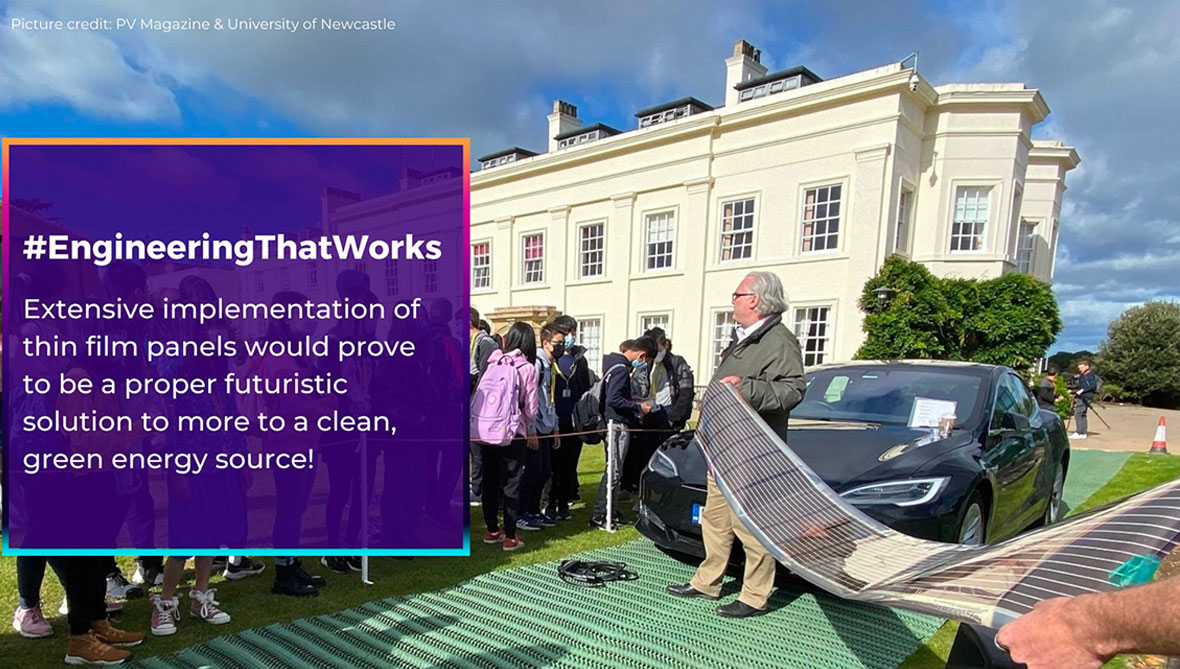Thin-Film Solar Panels – An Emerging Revolutionary Renewable Energy Technology

In recent times, the solar industry has gained much traction, with people becoming increasingly aware of using sustainable energy sources instead of energy generated from fossil fuels. With the increase in demand, researchers are constantly in the process of finding innovative solar solutions. One such ground-breaking solution is thin-film technology, a modern, cost-effective method to generate solar electricity. In contrast to traditional monocrystalline or polycrystalline PV solar panels, thin-film solar cells are thin, flexible, and effective in converting sunlight into energy.
In this article, let us explore, understand and dive into exciting details about this emerging revolutionary technology.
What is a Thin-Film Solar Panel?
Thin-film photovoltaic (PV) solar panels are similar to traditional solar panels in intent. However, thin-film panels are made of one or more thin layers (or films) of semiconducting materials placed between transparent conducting layers, with a layer of glass (metal or plastic) on top to capture the sunlight. The semiconducting materials are usually cadmium-telluride (CdTe) and copper-indium-gallium-selenide (CulnSe2). While amorphous silicon (a-Si) is also used to manufacture thin films, that silicon is not the conventionally used solid silicon wafer. But, the silicon used is the non-crystalline type of silicon. Among all the semiconducting materials used, thin-film solar panels made from CdTe occupy the largest share in the thin-film solar market.
Though these thin-film panels resemble a conventional silicon chip in terms of thickness and appearance, these films are 20 times thinner than the traditional crystalline silicon wafers and, therefore, versatile and easy to use. The thickness of these panels is extremely low and ranges from a few nanometers (nm) to tens of micrometers (µm).
As this technology continues to gain popularity, their implementation is not just restricted to rooftop solar panels but daily use applications too. For instance, solar-powered calculators are one of the widely used applications of thin-film solar panels.
Benefits of Thin-Film Solar Panels
With decades of research and exploration, thin-film panels are the most futuristic and promising technologies with umpteen number of benefits when compared to traditional rigid solar panels. Most importantly, these thin-film solar panels are lightweight, flexible, and cheap.
The Research group at the University of Newcastle, Australia, created thin printable PV solar panels using their proprietary technology that uses organic polymers to generate energy. In contrast, traditional PV solar panels use silicon. The University of Newcastle claims that the liquidity property of organic polymers facilitates conventional printers that print newspapers and books to print the thin printable PV panels. At a production cost of $10 per square meter, these panels are the most cost-effective, cheap renewable technology that can be rapidly produced and are also recyclable.
Moreover, considering these sheets are flexible and malleable, they can be installed on curved surfaces. They can also be used in a diverse range of applications, such as powering streetlights, watches, camping equipment, calculators, vehicles, and so on.
Additionally, installing a thin film solar panel is much easier and more cost-effective than conventional solar panels, as these printed sheets can be stuck to different surfaces using a specific adhesive tape. The limited weight of these panels is also an advantage considering that conventional panels are hefty, for instance, 15 kgs per square meter.
Points to Note - Before You Plan to Install Thin Film Solar Panels
Even though thin-film panels offer many advantages compared to rigid crystalline panels, you need to be aware of a couple of points before choosing the right panel for your use.
In terms of efficiency and power capacity, thin film panels tend to lag behind traditional crystalline solar panels. Therefore, thin-film solar panels need a lot of roof space to generate large amounts of energy, while conventional panels occupy less space to generate the same amount of energy.
Traditional solar panels outshine thin-film panels in terms of durability. You will also need to give a settling time for your thin-film panels before they can stabilize, and you can evaluate their actual output. Usually, this takes six months, which means for the initial six months, you might notice a significant increase in power generation which can be 20-25% more than their actual long-term energy output.
Despite the shortcomings, thin-film panels are making their mark in the solar industry. Due to its malleable nature, thin films can be used innovatively as solar roof tiles or window laminations for customers who want to go solar but retain the aesthetics of their rooftops.
Afterthoughts
The popularity and efficiency of thin-film solar panels have been increasing over time. They are predicted to overtake the rigid PV solar panels that have currently monopolized the market. These sheets can be installed on surfaces such as window blinds, cars, or uneven surfaces, where a conventional silicon panel is impossible to mount. Therefore, installing thin-film solar panels is vital to stimulate the development and commercialization of this fantastic technology and explore its reliability and performance. In addition, extensive implementations of thin-film panels would prove to be a proper futuristic solution to move to a clean, green energy source!
